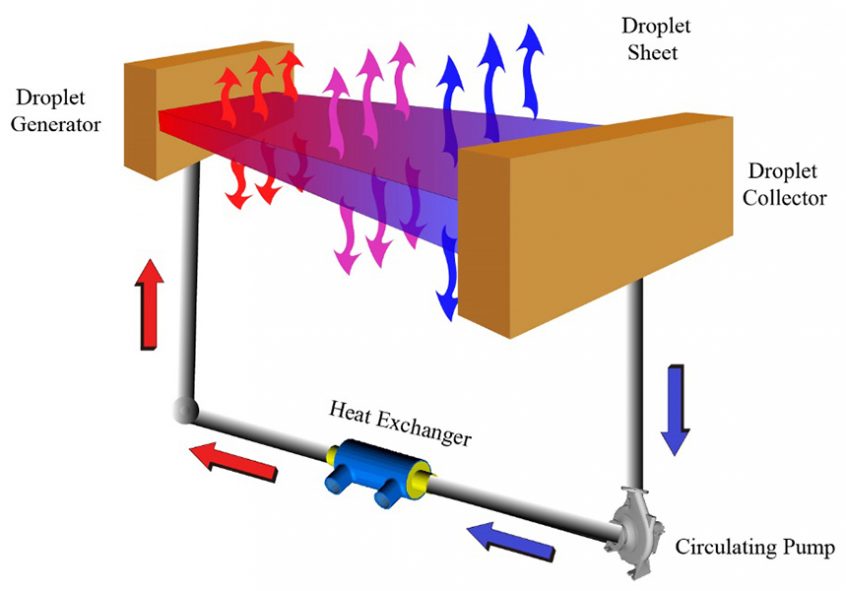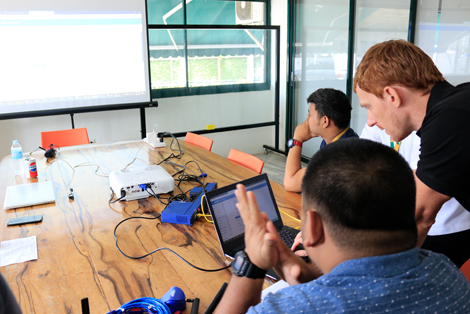Energy efficiency is a major concern in the data center industry. Organizations are always looking for the latest cooling technology to increase optimization. More facilities are exploring to free cooling solutions to save costs and cut carbon emissions.
Free cooling is a an attractive option for data centers. Instead of mechanical refrigeration, it uses naturally cool air or water to dissipate heat. Although it is not entirely free as you need to install fans or pumps, it greatly increases energy savings. Facilities in colder areas can leverage lower ambient air temperatures than those in warmer areas. Likewise, facilities near rivers, lakes, and oceans can optimize free cooling. Cooling systems can circulate the cold water from these natural resources through chillers.
Free cooling is used with air-side economizers and water-side economizers. Facilities may use air or water to incorporate a free cooling design in their system. Either way, it lessens power consumption for industrial cooling systems.
In this article, we discuss heat rejection methods in data centers. Learn how PUE and WUE affect data center optimization. Note the important considerations when choosing the heat rejection technology for your facility. We also look at the climate trends that may affect your facility’s cooling system.
Importance Of PUE And WUE In Heat Rejection Method
PUE and WUE are benchmarks for data center success. PUE and WUE measure data center systems’ density, efficiency, and sustainability. These two metrics significantly relate to measuring the heat rejection system’s performance.
PUE measures systems efficiency and performance. It refers to the total energy used in a facility and its IT components. PUE is used to test a facility’s energy costs and environmental impacts. WUE measures water consumption in data center systems. It refers to the ratio between water usage and energy consumption of IT components.
Different heat rejection methods have varying impacts on PUE and WUE. Dry air coolers tend to have zero impact on WUE but a high impact on PUE. Meanwhile, cooling towers have a relatively low impact on PUE but a significant impact on WUE. Other heat rejection methods like adiabatic and augmented dry coolers have lower PUE but higher WUE. Generally, cooling systems tend to have a higher impact on PUE than WUE.
The relationship between power and water consumption is complex. While water-based cooling systems may have lower power consumption, it leads to higher water usage. Climate change is another big concern in the industry as natural resources continue to deplete. Environmental experts estimate that by 2030, we will experience a 40% gap between global water supply and demand.
Thus, data center technology strives to cut consumption and lessen environmental impacts.
Types Of Heat Rejection Methods
The heat rejection method significantly impacts resource use and operating costs. It often rises in proportion to rising ambient temperatures. Cooling systems may decrease efficiency as free cooling potential decreases. Thus, it is vital to include a versatile heat rejection design in your facility.
Here are the common types of heat rejection methods in data centers.
-
Dry Cooler
This system uses air to remove heat in the facility. A dry cooler is typically made up of heat exchangers and fans. Fans direct airflow through heat exchangers, where hot air is cooled down. Then, it circulated back into the cooling system. In dry coolers, the air temperature must be lower than the chilled water. Hence, why dry coolers are more appropriate for facilities located in cold regions. Compared to cooling towers, dry coolers are unaffected by air humidity. But they also have limited cooling capacity. Cooling towers can bring the water temperature up to 5 degrees below ambient temperature. Dry coolers can only bring the water temperature down to ambient temperature.
-
Cooling Tower
This system uses water evaporation to remove heat. Here, air and water work together to decrease the water’s temperature. As water evaporates, a cooling action is created. Water temperature decreases and absorbs heat. There are different types of cooling towers. Each one is designed and works differently.
Moreover, cooling towers have a “wet fin effect” wherein some water directly evaporates on the fins. This component enhances the adiabatic cooling effect and dry cooler’s heat transfer. Unfortunately, spraying methods tend to increase corrosion risks in the long run. An advantage of this method is that it can be used to remove waste heat from server rooms to the atmosphere. It is a cost-efficient method that can improve your facility’s cooling system.
-
Adiabatic cooler
This system removes heat through changing air pressure caused by volume expansion. It uses free cooling potential to cool down facilities. It is much like a compromise between dry coolers and cooling towers. An adiabatic cooler can run as a dry cooler during low temperatures. In high temperatures and low humidity, it can work similarly to cooling towers. Water evaporation may be used to increase efficiency. Yet adiabatic coolers return slightly higher temperatures than cooling towers.
Dry coolers are suitable if your facility has lower ambient temperatures all year round. It is also ideal for facilities in areas with high humidity—even those facilities with no water resources. Incorporating an adiabatic cooler with a dry cooler will optimize its function. It can reduce dry but hot ambient temperatures, thus, increasing efficiency. With adiabatic dry coolers, a spray or padding system may be used to cause water evaporation. Bringing this to the ambient air, thus, decreasing air temperature.
Considerations When Choosing Heat Rejection Method
Choosing the right heat rejection method for your facility can be challenging. Be sure to consider these factors.
-
Ambient Air Temperature
ASHRAE recommends that data centers operate from 64 degrees to 81 degrees Fahrenheit. It is the optimal temperature for data centers. Operating below or above these temperatures would greatly disrupt uptime and hardware lifespan. If your facility is located in a colder area, dry air coolers would be a good option. Yet this heat rejection method would lead to a higher PUE impact.
-
Corrosion And Footprint Availability
Another variable to consider is the total suspended soils (TSS). It is also referred to as total dissolved solids (TDS) – like salt. Solid variables affect the proper fill for cooling towers. They can affect the performance of cooling systems. As they pose a risk of water contamination. To prevent corrosion and mineral deposits, abide by the restrictions of adiabatic coolers. “Clean water” with a low mineral deposit is essential for pad recirculation and spray systems. It is best to include water filtration and chemical systems to ensure water quality.
-
Water Availability And Evaporation
Consider the availability of water in your area. Water and ambient air are key factors in selecting a heat rejection system. Cooling towers are an optimal choice if your facility is large and located near a water source. It would give you less impact on PUE. But if your data center is located in a humid region, you might want to think more carefully. High humidity tends to limit cooling tower performance. It is also a concern in adiabatic and augmented systems.
-
Water Quality And Treatment
Water-based cooling systems are also sensitive to water qualities. You cannot use just any type of water. For cooling towers, wastewater, city water, and industrial water can be used. For adiabatic coolers, city water, spring water, and potable water are used. Rainwater can also be used here. As you may notice, the pollution level is the major consideration in water quality.
Monitor Heat Rejection Method With AKCP Monitoring Solutions
Maintaining the right temperature is a key factor in data center operations. Monitoring your cooling system is essential to improve efficiency and sustainability. We provide you with the best monitors for all your data center systems. Improve your facility’s efficiency with AKCP Thermal Map Sensors and AKCPro Server Heatmaps. Avoid overheating and overcooling. Identify hot spots and cold spots for optimal efficiency and lower PUE.
Monitor All Your AKCP Devices
AKCPro Server is our world-class central monitoring and management software. Suitable for a wide range of monitoring applications. Free to use for all AKCP devices. Check your infrastructure. Whether a single building or remote sites over a wide geographic area. Integrate third-party devices with Modbus, SNMP, and ONVIF compatible IP cameras.
- Integrated monitoring of all devices
AKCPro Server integrates all your systems in easy-to-use software. - Environmental Monitoring
Check all your temperature, humidity, airflow, water leak, and other environmental sensors. Configure rack maps to show the thermal properties of your computer cabinet. Check the temperature and temperature differentials. - Security Monitoring
Ensure that your facilities and critical infrastructure are secured. Door contact sensors and audible and visual alarms are configured. Manage them from your custom desktops in APS. - Power Monitoring
Check single-phase, three-phase generators and UPS battery backup power. AKCPPro Server performs live PUE calculations. So, you have a complete overview of your power train. Above all, how adjustments in your data center directly impact your PUE. - Access Control
AKCPro Server is used to administer the access rights and schedules for all AKCP devices. Secure your assets and control access. Generate reports to give a complete audited access trail. - Video Monitoring
Video feeds from Integrated ONVIF compatible IP cameras. Cameras connected to AKCP securityProbe base units can be monitored and recorded. Synchronize sensor events with a video playback window for “eyes on” any sensor events.
Conclusion
Cooling systems maintain facility temperatures. Hence, choosing the right heat rejection method is crucial for your facility. Optimize free cooling potential in your area. Consider ambient conditions, water availability, and quality in choosing heat rejection methods. Whichever method you choose, be sure to incorporate AKCP monitoring solutions.
Reference Links:
K°Focus_DCC_FocalPaper_HeatRejection.pdf
https://www.techtarget.com/searchdatacenter/definition/free-cooling#:~:text=Free%20cooling%20is%20an%20approach,water%20instead%20of%20mechanical%20refrigeration.
https://submer.com/blog/pue-cue-and-wue-what-do-these-three-metrics-represent-and-which-is-one-is-the-most-important/
https://history-computer.com/ambient-temperature-and-why-it-matters-for-data-centers/
https://submer.com/submer-academy/library/dry-cooler/
https://www.spxcooling.com/coolingtowers/
https://www.techtarget.com/whatis/definition/adiabatic-cooling#:~:text=Adiabatic%20cooling%20is%20the%20process,natural%20phenomena%20to%20regulate%20temperature.





